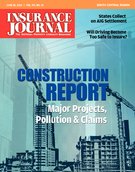The Final Round in Steadfast, But the Opening of a Broader Debate?
It is hard to say whether one should be surprised that the Virginia Supreme Court recently reaffirmed in Steadfast Insurance Company v. The AES Corporation the circuit court’s judgment that Steadfast had no duty under its CGL policies to defend its insured, AES Corp., against climate change/ global warming claims.
When the Virginia circuit court issued its ruling on Feb. 5, 2010, in favor of the insurer, it was the first court to issue an opinion on insurance coverage of global warming/climate change claims. As a result, insurers and insureds alike watched closely to see how the appellate courts in Virginia would rule on the issue.
On Sept. 16, 2011, the Virginia Supreme Court issued an opinion affirming the circuit court’s ruling and the matter seemed settled, at least in Virginia. However, on Jan. 17, 2012, the Virginia Supreme Court unexpectedly vacated its Sept. 16, 2011, opinion and granted a rehearing.
The move was unexpected because rehearings are rarely granted and none of the judges had dissented from the original opinion, though there was a concurring opinion of two justices. Although there was nothing apparent in the opinion to suggest the Court would reverse its affirmance, the mere fact that a rehearing had been granted suggested that a reversal was likely. Thus, there was an element of surprise when on April 20 the Virginia Supreme Court issued an opinion re-affirming the circuit court’s judgment in favor of Steadfast and against AES.
The reason for the rehearing is difficult to discern because the opinion on rehearing is identical to the original opinion issued on Sept. 16, 2011, except for the addition of two new paragraphs and one footnote near the end.
It appears that the majority was attempting to answer a concern raised in the concurring opinion to the original opinion. But, following the rehearing, at least one justice, ironically a member of the majority to the original opinion, seemed to find the majority’s attempt to be wanting and concurred to warn that the Court was heading “inexorably to a day of reckoning that may surprise many policy holders.”
The “day of reckoning” suggested by the concurring justice seems to be the possibility that the logical result of Virginia precedents interpreting CGL policies is that for any particular incident, a CGL policy will either (a) provide no coverage of the incident or (b) not cover the damages resulting from the incident.
Thus, while the latest ruling in Steadfast may be the final word on one aspect of potential coverage of climate change claims, at least in Virginia, it may open up a much broader debate about all forms of coverage under CGL policies.
The Steadfast Litigation and The Virginia Supreme Court’s Decision
In Village of Kivalina v. ExxonMobil, et. al., the Alaskan Village of Kivalina alleged that AES Corp. and the other defendants were emitting excessive amounts of carbon dioxide and other greenhouse gases that were causing global warming, resulting in the loss of Arctic sea ice that protected the Kivalina coast from winter storms. AES sought defense of this claim under a CGL “occurrence” policy issued by Steadfast. Steadfast agreed to defend under a reservation of rights, but filed suit in Virginia seeking a declaratory judgment that it had no duty to defend AES in the Village of Kivalina lawsuit.
In the declaratory judgment suit, the district court, without providing reasons, granted summary judgment in favor of Steadfast on Feb. 5, 2010, “because no ‘occurrence’ as defined in the policies has been alleged in the underlying Complaint.” AES appealed.
On Sept. 16, 2011, the Virginia Supreme Court affirmed the district court’s ruling. The Court began its opinion by noting that under Virginia law, Steadfast’s duty to defend was to be determined solely on the allegations in the Village of Kivalina complaint and the terms of the Steadfast insurance policy.
The Steadfast policy defined “occurrence” as an “accident.” Virginia law defines “accident” as an “event which creates an effect which is not the natural or probable consequence of the means employed and is not intended, designed or reasonably anticipated.” The Village of Kivalina complaint alleged that AES “intentionally” released “tons” of greenhouse gases into the atmosphere.
The Court stated that while intentional acts are not “accidents,” a resulting injury that was out of the ordinary expectation of a reasonable person could nonetheless be covered under an “occurrence” policy even though the insured’s action which started a chain of events was intentional.
However, the Village of Kivalina complaint also alleged that there was “a clear scientific consensus” that the damages alleged in the complaint were the natural and probable consequence of the emission of greenhouse gases.
As the Court stated: “Inherent in such an allegation is the assertion that the results were a consequence of AES’s intentional actions that a reasonable person would anticipate.” Therefore, the Court concluded that the Village of Kivalina complaint did not allege an “occurrence” within the meaning of the Steadfast CGL policy and, thus, there was no coverage or duty to defend.
The Concurring Opinion and the Rehearing Opinion’s Response
Justice Koontz, joined by Justice Carrico, concurred in the Court’s result, but expressed a concern that:
“[Steadfast’s] argument focuses on the allegations of the Kivalina complaint which assert that AES’ actions were intentional and had foreseeable consequences about which AES ‘knew or should have known’ and, thus, that the resulting ‘occurrence’ was not an ‘accident’ within the meaning of the CGL policies even if those actions were, as the complaint alleges, also ‘negligent.’ I share the concern expressed by AES that this argument paints with too broad a stroke.
“In my opinion, the majority does not adequately explain that the argument which Steadfast makes here would not be applicable to the vast majority of cases where a policyholder seeks to have his insurance company provide him with a defense for an accidental tortious injury.”
More specifically, Judge Koontz noted that Parker v. Hartford Fire Insurance was the leading Virginia case on the issues presented and “the distinction the majority draws between Parker and this case does not resolve my concern this case could be misconstrued as departing from” the holding of Parker.
To address this concern, the Court granted rehearing and added the following two paragraphs near the end of its original opinion:
“The dissimilarity between the allegations in the Kivalina complaint and those in most other tort actions for bodily injury or property damage is the relevant intentional or negligent act alleged in the complaint.
Kivalina does not allege that AES’s intentional acts were done negligently. The complaint alleges that AES was ‘negligent’ only in the sense that it ‘knew or should have known’ that its actions would cause injury no matter how they were performed.
“Under the CGL policies, Steadfast would not be liable because AES’s acts as alleged in the complaint were intentional and the consequences of those acts are alleged by Kivalina to be not merely foreseeable, but natural or probable. Where the harmful consequences of an act are alleged to have been not just possible, but the natural or probable consequences of an intentional act, choosing to perform the act deliberately, even if in ignorance of that fact, does not make the resulting injury an ‘accident’ even when the complaint alleges that such action was negligent.”
The Concurring Opinion to the Rehearing Opinion
For Justice Mims, who was a member of the majority for the original opinion, this explanation raised more troubling possibilities than it answered. She agreed with the result in favor of Steadfast, but disagreed that “the reasoning can be limited to” the Steadfast policy and the Kivalina complaint, thus “leading inexorably to a day of reckoning that may surprise policy holders.”
Justice Mims explained her concern as follows:
“[W]e have defined accident in various ways. For example, an accident means ‘an incident that was unexpected from the viewpoint of the insured,’ and ‘an event which creates an effect which is not the natural or probable consequence of the means employed and is not intended, designed or reasonably anticipated.’
“But this creates a dichotomy. If the injurious consequences of an action is not the natural or probable consequence of the action, there can be no actionable negligence. To prevail in an action for negligence, the plaintiff must prove the existence of a legal duty, a breach of the duty and that the breach of the duty proximately caused his injury.
“The majority opinion is only half right when it states that ‘allegations of negligence are not synonymous with allegations of an accident.’ In fact, under the reasoning of our precedents, allegations of negligence and allegations of accident must be mutually exclusive.
“In other words, to recover on a negligence claim, a plaintiff’s allegations can not allege an ‘accident.’ But, at the same time, the Virginia courts have construed the term ‘occurrence’ under CGL policies to be synonymous with the term ‘accident.’ As a result, coverage, and the duty to defend, under a CGL policy requires allegation and proof of an accident, but if the plaintiff alleges and proves an ‘accident,’ then a claim for negligence can not exist.”
Therefore, Judge Mims concluded that: “Accordingly, while I agree with my colleagues that Steadfast had no duty to defend AES in the underlying action based on the CGL policy in this case, I also must acknowledge the broader effect that this conclusion, and the underlying case law that compels it, may have on other CGL policies in which the insured risk is defined as an ‘occurrence.’ Our precedents may have painted us into a jurisprudential corner.”
The End Result
The end result of the Steadfast series of rulings is that the first word on coverage of climate change claims has been spoken and it favors insurers. However, the favorable ruling was on a narrow basis which could potentially be different based on how the claims are alleged by plaintiffs rather than on the more concrete, and universal, basis of the pollution exclusion.
While the concurring opinion suggests that the final Steadfast opinion could create broad exceptions to coverage — indeed, the possibility that coverage could be the exception rather than the rule — it seems highly unlikely that Virginia courts, or courts in other states with similar definitions of “occurrence” and “accident,” would allow that to happen.
In fact, it is more likely that the courts will clarify or re-define the meaning of those terms with the possible result that coverage is expanded until policies are revised to take into account whatever changes may come about.
Topics Climate Change Virginia
Was this article valuable?
Here are more articles you may enjoy.


 North Carolina Sting Operation Alleges Roofer Damaged Shingles to File Claim
North Carolina Sting Operation Alleges Roofer Damaged Shingles to File Claim  ‘Door Knocker’ Roofers Were Everywhere. NC Farm Bureau Saw an Opportunity
‘Door Knocker’ Roofers Were Everywhere. NC Farm Bureau Saw an Opportunity  WTW to Acquire Newfront in Deal Worth Up to $1.3B
WTW to Acquire Newfront in Deal Worth Up to $1.3B  Insurance Industry ‘Megadeals’ Dominate 2025, Says PwC
Insurance Industry ‘Megadeals’ Dominate 2025, Says PwC 


